8 books about Parker, Jonathan A.
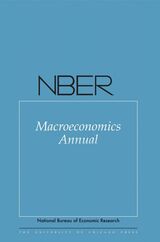
NBER Macroeconomics Annual 2012
Volume 27
Edited by Daron Acemoglu, Jonathan Parker, and Michael Woodford
University of Chicago Press Journals, 2013
The twenty-seventh edition of the NBER Macroeconomics Annual continues a tradition of featuring theoretical and empirical contributions that shed light on central issues in contemporary macroeconomics, pushing the frontiers of macroeconomic research on topics related to both the business cycle and economic growth and addressing important policy-relevant questions. This year’s volume features two papers that illuminate two causes of the recent financial crisis: how firms accessed credit during the financial crisis and how the risk in mortgage lending was measured in the UK in the decades before the crisis. Other papers in this volume include a study of individual prices over time that draws out the implications of observed price adjustment for macroeconomic models of price stickiness, a focus on the implications of microeconomic estimates of labor supply for the determination of employment rates, a study of the empirical validity of the Keynesian explanation for employment declines during recessions, and an innovative paper that measures the efficacy of fiscal stimulus by looking at the economic impact of changes in federal highway spending across US states.
[more]
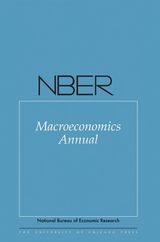
NBER Macroeconomics Annual 2013
Volume 28
Edited by Jonathan Parker and Michael Woodford
University of Chicago Press Journals, 2014
The twenty-eighth edition of the NBER Macroeconomics Annual continues its tradition of featuring theoretical and empirical research on central issues in contemporary macroeconomics. As in previous years, this volume not only addresses recent developments in macroeconomics, but also takes up important policy-relevant questions and opens new debates that will continue for years to come. The first two papers in this year’s issue tackle fiscal and monetary policy, asking how interest rates and inflation can remain low despite fiscal policy behavior that appears inconsistent with a monetary policy regime focused only on inflation and output and not on fiscal balances as recently observed in the U.S. The third examines the implications of reference-dependent preferences and moral hazard in employment fluctuations in the labor market. The fourth paper addresses money and inflation, analyzing the long run inflation rate, the coexistence of money with pledgeable and money-like assets, and why inflation did not increase in response to business-cycle fluctuations in productivity. And the fifth looks at the stock market and how it relates to the real economy. The final chapter discusses the large and public shift towards more expansionary monetary policy that has recently occurred in Japan.
[more]
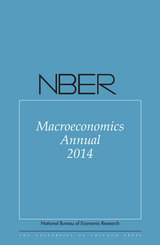
NBER Macroeconomics Annual 2014
Volume 29
Edited by Jonathan Parker and Michael Woodford
University of Chicago Press Journals, 2015
The twenty-ninth edition of the NBER Macroeconomics Annual continues its tradition of featuring theoretical and empirical research on central issues in contemporary macroeconomics. Two papers in this year’s issue deal with recent economic performance: one analyzes the evolution of aggregate productivity before, during, and after the Great Recession, and the other characterizes the factors that have contributed to slow economic growth following the Great Recession. Another pair of papers tackles the role of information in business cycles. Other contributions address how assumptions about sluggish nominal price adjustment affect the consequences of different monetary policy rules and the role of business cycles in the long-run decline in the share of employment in middle-wage jobs. The final chapter discusses the advantages and disadvantages of the elimination of physical currency.
[more]
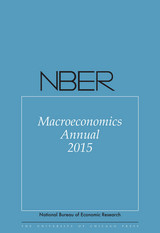
NBER Macroeconomics Annual 2015
Volume 30
Edited by Martin Eichenbaum and Jonathan Parker
University of Chicago Press Journals, 2016
This year, the NBER Macroeconomics Annual celebrates its thirtieth volume. The first two papers examine China’s macroeconomic development. “Trends and Cycles in China's Macroeconomy” by Chun Chang, Kaiji Chen, Daniel F. Waggoner, and Tao Zha outlines the key characteristics of growth and business cycles in China. “Demystifying the Chinese Housing Boom” by Hanming Fang, Quanlin Gu, Wei Xiong, and Li-An Zhou constructs a new house price index, showing that Chinese house prices have grown by ten percent per year over the past decade. The third paper, “External and Public Debt Crises” by Cristina Arellano, Andrew Atkeson, and Mark Wright, asks why there appear to be large differences across countries and subnational jurisdictions in the effect of rising public debts on economic outcomes. The fourth, “Networks and the Macroeconomy: An Empirical Exploration” by Daron Acemoglu, Ufuk Akcigit, and William Kerr, explains how the network structure of the US economy propagates the effect of gross output productivity shocks across upstream and downstream sectors. The fifth and sixth papers investigate the usefulness of surveys of household’s beliefs for understanding economic phenomena. “Expectations and Investment,” by Nicola Gennaioli, Yueran Ma, and Andrei Shleifer, demonstrates that a chief financial officer's expectations of a firm's future earnings growth is related to both the planned and actual future investment of that firm. “Declining Desire to Work and Downward Trends in Unemployment and Participation” by Regis Barnichon and Andrew Figura shows that an increasing number of prime-age Americans who are not in the labor force report no desire to work and that this decline accelerated during the second half of the 1990s.
[more]
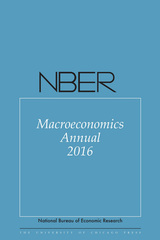
NBER Macroeconomics Annual 2016
Edited by Martin Eichenbaum and Jonathan Parker
University of Chicago Press Journals, 2017
The thirty-first edition of the NBER Macroeconomics Annual features theoretical and empirical research on central issues in contemporary macroeconomics. The first two papers are rigorous and data-driven analyses of the European financial crisis. The third paper introduces a new set of facts about economic growth and financial ratios as well as a new macrofinancial database for the study of historical financial booms and busts. The fourth paper studies the historical effects of Federal Reserve efforts to provide guidance about the future path of the funds rate. The fifth paper explores the distinctions between models of price setting and associated nominal frictions using data on price setting behavior. The sixth paper considers the possibility that the economy displays nonlinear dynamics that lead to cycles rather than long-term convergence to a steady state. The volume also includes a short paper on the decline in the rate of global economic growth.
[more]
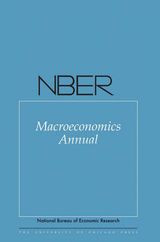
NBER Macroeconomics Annual 2017
Volume 32
Edited by Jonathan A. Parker and Martin Eichenbaum
University of Chicago Press Journals, 2018
Volume 32 of the NBER Macroeconomics Annual features six theoretical and empirical studies of important issues in contemporary macroeconomics, and a keynote address by former IMF chief economist Olivier Blanchard. In one study, SeHyoun Ahn, Greg Kaplan, Benjamin Moll, Thomas Winberry, and Christian Wolf examine the dynamics of consumption expenditures in non-representative-agent macroeconomic models. In another, John Cochrane asks which macro models most naturally explain the post-financial-crisis macroeconomic environment, which is characterized by the co-existence of low and nonvolatile inflation rates, near-zero short-term interest rates, and an explosion in monetary aggregates. Manuel Adelino, Antoinette Schoar, and Felipe Severino examine the causes of the lending boom that precipitated the recent U.S. financial crisis and Great Recession. Steven Durlauf and Ananth Seshadri investigate whether increases in income inequality cause lower levels of economic mobility and opportunity. Charles Manski explores the formation of expectations, considering the efficacy of directly measuring beliefs through surveys as an alternative to making the assumption of rational expectations. In the final research paper, Efraim Benmelech and Nittai Bergman analyze the sharp declines in debt issuance and the evaporation of market liquidity that coincide with most financial crises. Blanchard’s keynote address discusses which distortions are central to understanding short-run macroeconomic fluctuations.
[more]
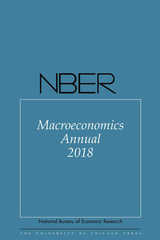
NBER Macroeconomics Annual 2018
Volume 33
Edited by Martin Eichenbaum and Jonathan A. Parker
University of Chicago Press Journals, 2019
This volume contains six studies on current topics in macroeconomics. The first shows that while assuming rational expectations is unrealistic, a finite-horizon forward planning model can yield results similar to those of a rational expectations equilibrium. The second explores the aggregate risk of the U.S. financial sector, and in particular whether it is safer now than before the 2008 financial crisis. The third analyzes “factorless income,” output that is not measured as capital or labor income. Next, a study argues that the financial crisis increased the perceived risk of a very bad economic and financial outcome, and explores the propagation of large, rare shocks. The next paper documents the substantial recent changes in the manufacturing sector and the decline in employment among prime-aged Americans since 2000. The last paper analyzes the dynamic macroeconomic effects of border adjustment taxes.
[more]
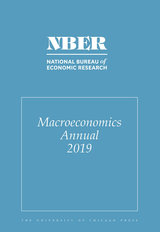
NBER Macroeconomics Annual 2019
Volume 34
Edited by Martin Eichenbaum, Erik Hurst, and Jonathan A. Parker
University of Chicago Press Journals, 2020
The thirty-fourth volume of the NBER Macroeconomics Annual features theoretical and empirical studies of issues in contemporary macroeconomics and a keynote address by James Stock, a member of President Obama’s Council of Economic Advisers from 2013 to 2014. Chong-en Bai, Chang-Tai Hsieh, and Zheng Song examine the “special deals” provided by Chinese local governments to favored private firms and their effects on economic growth. Matias Covarrubias, Germán Gutiérrez, and Thomas Philippon study the evolution of profits, investment, and market shares in US industries over the past forty years and find evidence of inefficient concentration and barriers to entry since 2000. David Debortoli, Jordi Galí, and Luca Gambetti assess whether recent economic performance was affected by a binding zero lower bound constraint on the interest rate. Michael McLeay and Silvana Tenreyro explain why it is difficult to empirically identify the Phillips curve (a key element of the policy framework used by central banks) using aggregate data. The authors suggest using regional variation in unemployment and inflation to estimate the relationship between these variables. Margherita Borella, Mariacristina De Nardi, and Fang Yang examine the effects of shorter life expectancies, higher medical expenses, and lower wages for white, non-college-educated Americans born in the 1960s on labor supply and retirement savings. Nir Jaimovich, Sergio Rebelo, Arlene Wong, and Miao Ben Zhang investigate the role that increases in the quality of the goods consumed (“trading up”) played in the rise of the skill premium that occurred in the last four decades.
[more]
READERS
Browse our collection.
PUBLISHERS
See BiblioVault's publisher services.
STUDENT SERVICES
Files for college accessibility offices.
UChicago Accessibility Resources
home | accessibility | search | about | contact us
BiblioVault ® 2001 - 2025
The University of Chicago Press









